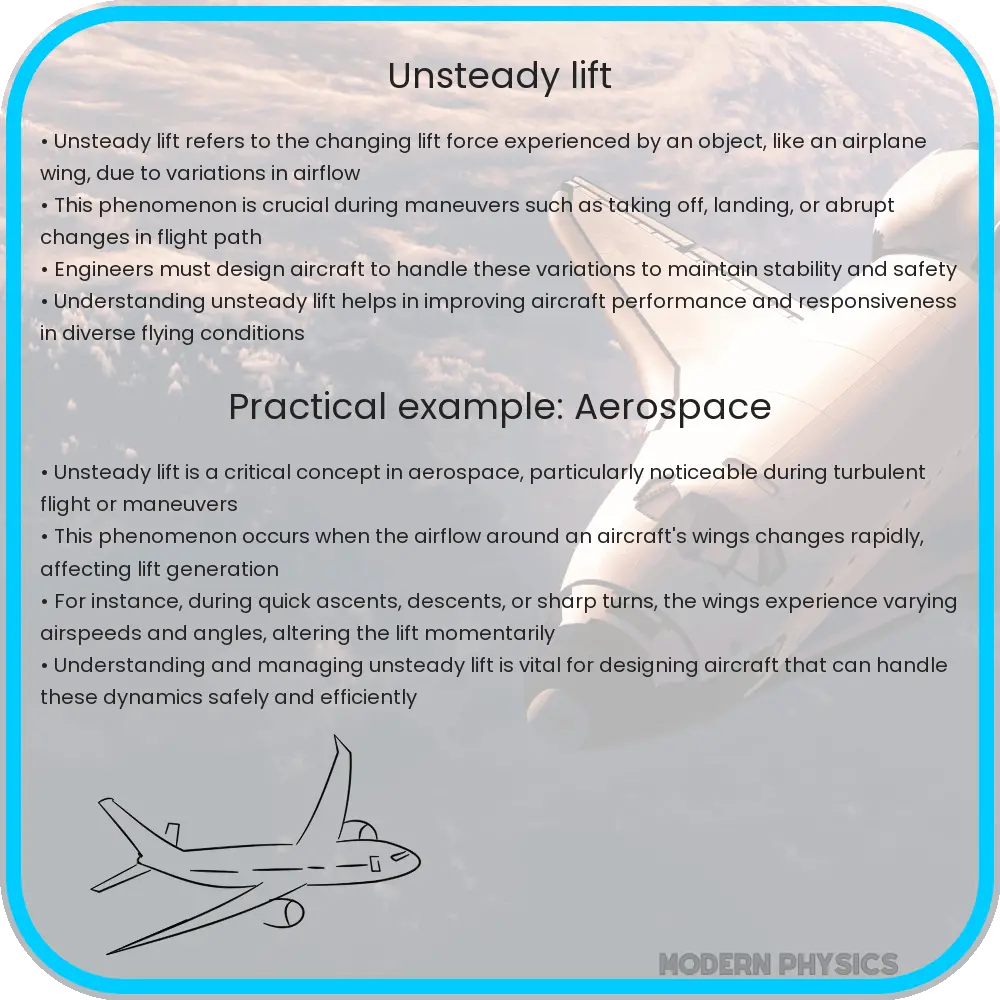Explore the dynamics of unsteady lift in fluid dynamics, a crucial concept for understanding the changing aerodynamic forces on objects like aircraft wings and turbines in varying flow conditions.

Understanding Unsteady Lift in Fluid Dynamics
Unsteady lift is a phenomenon in fluid dynamics that is critical to understanding how the forces acting on bodies, such as aircraft wings or turbine blades, change over time in response to varying flow conditions. Unlike steady lift, which deals with constant aerodynamic forces, unsteady lift considers fluctuating conditions that are more realistic in everyday environments.
Dynamic Analysis of Unsteady Lift
The analysis of unsteady lift begins by examining how airflow changes around a body. When an object moves through a fluid, or when fluid flows past a stationary object, the relative motion causes the fluid particles to rearrange, creating variations in pressure and flow velocity around the object. These variations can happen due to numerous factors such as changes in speed, direction of motion, or even the properties of the fluid itself.
To analytically study these dynamic changes, we often turn to the Navier-Stokes equations. These set of equations govern the motion of fluid substances and provide a comprehensive framework for modeling fluid dynamics. For unsteady aerodynamic performance, particular interest lies in the time-dependent terms of these equations, which help us understand how lift changes with time.
Factors Influencing Unsteady Lift
- Angle of Attack: This is the angle between the oncoming air or fluid stream and the reference line on the body (often the chord line of an airfoil). A changing angle of attack, which can occur during maneuvers in aircraft or in oscillating wind conditions for turbines, greatly affects unsteady lift.
- Flow Separation: When the airflow separates from the surface of the body, it leads to a sudden change in pressure distributions thereby affecting the lift. Flow separation can occur due to abrupt movements, changes in flow velocity, or when transitioning through different flow regimes.
- Shape and Size of the Body: The geometric shape and dimensions of a body influence how the flow interacts with it. Modifications in geometry, even small ones, can significantly alter the characteristics of unsteady lift.
The Computational Simulation of Unsteady Lift
Computational Fluid Dynamics (CFD) plays a crucial role in studying and predicting unsteady lift. By using numerical analysis and algorithms, CFD simulations allow engineers and researchers to visualize and quantify the flow around objects under different conditions. This becomes particularly useful in designing airfoils or blades where experimental testing might be either impractical or expensive.
These simulations typically involve discretizing the fluid domain into a mesh and solving the Navier-Stokes equations at each point within the mesh over time. Factors like mesh size, time step, and turbulence models need careful consideration to ensure the accuracy of the simulation.
Understanding and predicting unsteady lift is not only important for aeronautical engineering but also has implications in several other fields such as marine engineering, automotive design, and sports sciences. As fluid conditions in the natural environment are seldom constant, mastering this aspect of fluid motion is essential for the development of efficient and reliable designs in technology and engineering.
Experimental Methods in Unsteady Lift Analysis
To complement computational simulations, experimental analysis provides invaluable real-world data on unsteady lift. Techniques such as Particle Image Velocimetry (PIV) and Laser Doppler Anemometry (LDA) are commonly used to measure the velocity field around the object. These methods enable researchers to visualize the flow pattern and quantify the unsteady behavior of the lift force as conditions change.
Wind tunnels also play a pivotal role in the experimental study of unsteady lift. By adjusting the wind speed, direction, and even turbulence levels, engineers can simulate a variety of scenarios. The data collected from these experiments are critical for validating and refining both analytical models and computational simulations.
Practical Applications and Future Directions
The insights gained from studying unsteady lift have significant practical applications. In aerospace, understanding and managing unsteady lift is essential for the design of aircraft that are stable and efficient under various atmospheric conditions. In renewable energy, optimizing the design of wind turbine blades for unsteady lift can lead to more efficient power generation.
Looking towards the future, the ongoing development of more sophisticated computational models and enhanced experimental techniques promises to deepen our understanding of unsteady lift. Researchers are also exploring the potential of machine learning algorithms to predict unsteady lift phenomena, which could revolutionize how designs are created and tested.
Conclusion
Unsteady lift is a complex yet fascinating aspect of fluid dynamics with profound implications across multiple engineering disciplines. From the maneuvers of an aircraft to the efficient operation of wind turbines, understanding the dynamic changes in lift forces under varying conditions is crucial. Through a combination of analytical modeling, computational simulation, and experimental data, engineers and researchers are better equipped to predict and utilize unsteady lift for optimized performance and safety. The ongoing advancements in computational power, experimental tools, and theoretical understanding are paving the way for even more innovative applications in technology and design.
As we continue to push the boundaries of what is possible in engineering and fluid dynamics, unsteady lift remains a key area of research that promises to influence the next generation of technological advancements. Whether you are a student, a professional engineer, or simply a curious mind, grasping the principles of unsteady lift can provide a deeper appreciation of the natural and engineered systems that surround us.
